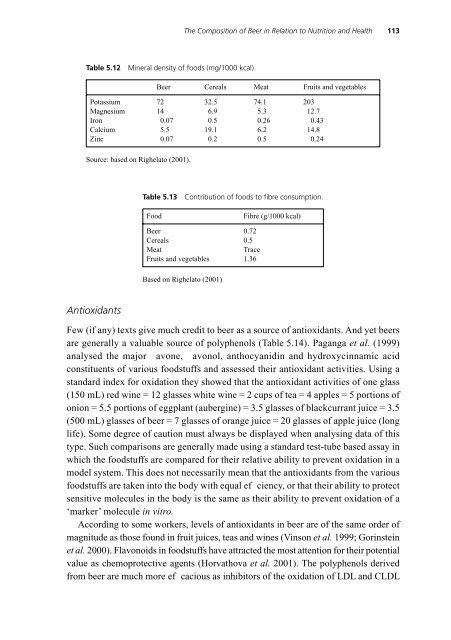Beer : Health and Nutrition
Beer : Health and Nutrition
Beer : Health and Nutrition
Create successful ePaper yourself
Turn your PDF publications into a flip-book with our unique Google optimized e-Paper software.
Table 5.12 Mineral density of foods (mg/1000 kcal).<br />
Antioxidants<br />
The Composition of <strong>Beer</strong> in Relation to <strong>Nutrition</strong> <strong>and</strong> <strong>Health</strong> 113<br />
<strong>Beer</strong> Cereals Meat Fruits <strong>and</strong> vegetables<br />
Potassium 72 32.5 74.1 203<br />
Magnesium 14 6.9 5.3 12.7<br />
Iron 0.07 0.5 0.26 0.43<br />
Calcium 5.5 19.1 6.2 14.8<br />
Zinc 0.07 0.2 0.5 0.24<br />
Source: based on Righelato (2001).<br />
Table 5.13 Contribution of foods to fibre consumption.<br />
Food Fibre (g/1000 kcal)<br />
<strong>Beer</strong> 0.72<br />
Cereals 0.5<br />
Meat Trace<br />
Fruits <strong>and</strong> vegetables 1.36<br />
Based on Righelato (2001)<br />
Few (if any) texts give much credit to beer as a source of antioxidants. And yet beers<br />
are generally a valuable source of polyphenols (Table 5.14). Paganga et al. (1999)<br />
analysed the major avone, avonol, anthocyanidin <strong>and</strong> hydroxycinnamic acid<br />
constituents of various foodstuffs <strong>and</strong> assessed their antioxidant activities. Using a<br />
st<strong>and</strong>ard index for oxidation they showed that the antioxidant activities of one glass<br />
(150 mL) red wine = 12 glasses white wine = 2 cups of tea = 4 apples = 5 portions of<br />
onion = 5.5 portions of eggplant (aubergine) = 3.5 glasses of blackcurrant juice = 3.5<br />
(500 mL) glasses of beer = 7 glasses of orange juice = 20 glasses of apple juice (long<br />
life). Some degree of caution must always be displayed when analysing data of this<br />
type. Such comparisons are generally made using a st<strong>and</strong>ard test-tube based assay in<br />
which the foodstuffs are compared for their relative ability to prevent oxidation in a<br />
model system. This does not necessarily mean that the antioxidants from the various<br />
foodstuffs are taken into the body with equal ef ciency, or that their ability to protect<br />
sensitive molecules in the body is the same as their ability to prevent oxidation of a<br />
‘marker’ molecule in vitro.<br />
According to some workers, levels of antioxidants in beer are of the same order of<br />
magnitude as those found in fruit juices, teas <strong>and</strong> wines (Vinson et al. 1999; Gorinstein<br />
et al. 2000). Flavonoids in foodstuffs have attracted the most attention for their potential<br />
value as chemoprotective agents (Horvathova et al. 2001). The polyphenols derived<br />
from beer are much more ef cacious as inhibitors of the oxidation of LDL <strong>and</strong> CLDL

















